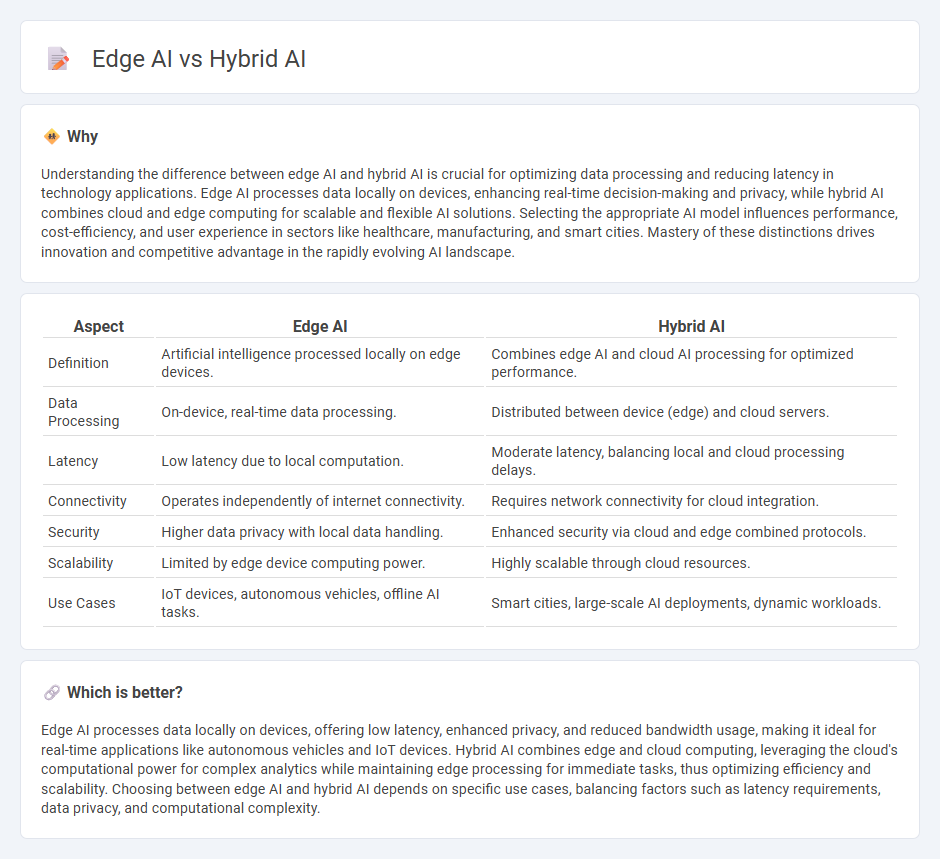
Edge AI processes data locally on devices, reducing latency and enhancing real-time decision-making, ideal for applications requiring immediate responses like autonomous vehicles and IoT sensors. Hybrid AI combines edge and cloud computing, leveraging the speed of local processing with the scalability and power of cloud analytics to optimize performance across diverse environments. Discover more about the benefits and applications of Edge AI and Hybrid AI in transforming modern technology.
Why it is important
Understanding the difference between edge AI and hybrid AI is crucial for optimizing data processing and reducing latency in technology applications. Edge AI processes data locally on devices, enhancing real-time decision-making and privacy, while hybrid AI combines cloud and edge computing for scalable and flexible AI solutions. Selecting the appropriate AI model influences performance, cost-efficiency, and user experience in sectors like healthcare, manufacturing, and smart cities. Mastery of these distinctions drives innovation and competitive advantage in the rapidly evolving AI landscape.
Comparison Table
| Aspect | Edge AI | Hybrid AI |
|---|---|---|
| Definition | Artificial intelligence processed locally on edge devices. | Combines edge AI and cloud AI processing for optimized performance. |
| Data Processing | On-device, real-time data processing. | Distributed between device (edge) and cloud servers. |
| Latency | Low latency due to local computation. | Moderate latency, balancing local and cloud processing delays. |
| Connectivity | Operates independently of internet connectivity. | Requires network connectivity for cloud integration. |
| Security | Higher data privacy with local data handling. | Enhanced security via cloud and edge combined protocols. |
| Scalability | Limited by edge device computing power. | Highly scalable through cloud resources. |
| Use Cases | IoT devices, autonomous vehicles, offline AI tasks. | Smart cities, large-scale AI deployments, dynamic workloads. |
Which is better?
Edge AI processes data locally on devices, offering low latency, enhanced privacy, and reduced bandwidth usage, making it ideal for real-time applications like autonomous vehicles and IoT devices. Hybrid AI combines edge and cloud computing, leveraging the cloud's computational power for complex analytics while maintaining edge processing for immediate tasks, thus optimizing efficiency and scalability. Choosing between edge AI and hybrid AI depends on specific use cases, balancing factors such as latency requirements, data privacy, and computational complexity.
Connection
Edge AI processes data locally on devices, reducing latency and enhancing real-time decision-making, while hybrid AI integrates edge AI with cloud-based systems for a balanced approach to data processing and analysis. This connection allows for optimized performance by leveraging the strengths of both local computation and centralized resources. Hybrid AI systems use edge AI to handle immediate, device-level intelligence and cloud AI to perform complex tasks, improving efficiency and scalability in various applications.
Key Terms
Model Architecture
Hybrid AI integrates cloud-based machine learning models with edge computing to balance computational efficiency and real-time responsiveness, leveraging complex neural networks and data fusion techniques. Edge AI employs lightweight, optimized models like CNNs and transformers designed for on-device inference, prioritizing low latency and privacy by processing data locally. Discover more about how these architectures shape AI performance across industries.
Deployment Location
Hybrid AI combines cloud-based processing with edge computing to optimize data handling and reduce latency, enabling complex analytics across distributed environments. Edge AI processes data locally on devices or edge servers, ensuring real-time decision-making and enhanced privacy by minimizing data transmission to central servers. Explore in-depth comparisons of hybrid AI and edge AI deployment locations and their impact on performance and applications.
Latency
Hybrid AI combines cloud computing and local processing to balance latency and computational power, while edge AI processes data entirely on local devices, drastically reducing latency by eliminating reliance on cloud communication. Edge AI is ideal for applications requiring real-time responsiveness, such as autonomous vehicles and industrial automation, where milliseconds matter. Explore deeper insights into how latency impacts performance in hybrid AI and edge AI scenarios.
Source and External Links
What is Hybrid AI? An Approach for Data Discovery - Hybrid AI combines machine learning's statistical data analysis with symbolic AI's semantic knowledge representation, allowing more powerful and context-aware AI systems that simulate brain-like reasoning by integrating scalable data insights with meaningful reasoning processes.
What is hybrid AI? - Information Age - Hybrid AI merges different AI technologies such as symbolic reasoning and machine learning to improve accuracy, interpretability, flexibility, and robustness in applications including healthcare diagnostics, fraud detection, and autonomous driving.
What is Hybrid AI? Everything you need to know - Hybrid AI leverages symbolic AI for transparent decision-making and knowledge embedding alongside machine learning for data-driven tasks, enabling explainable AI solutions like automating medical claim coding while maintaining human oversight.
 dowidth.com
dowidth.com